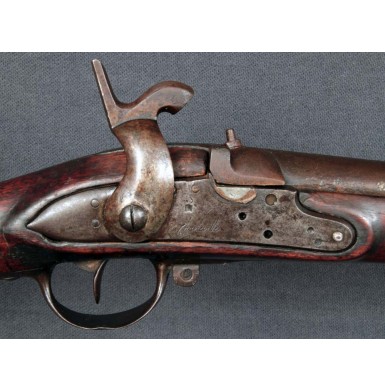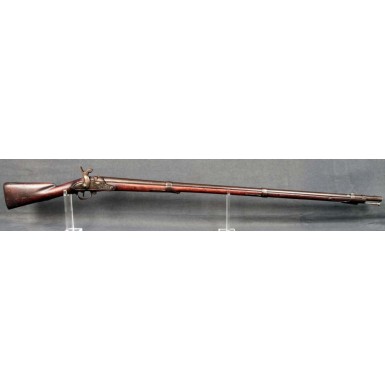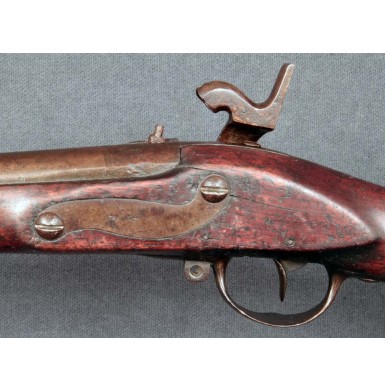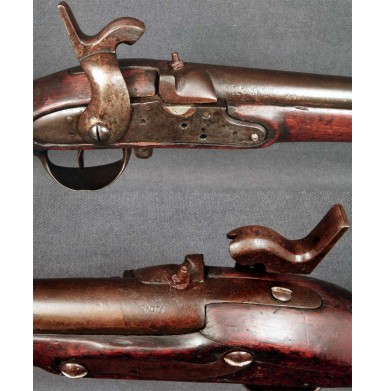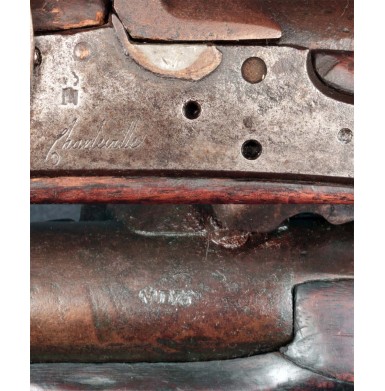Confederate Altered Charleville Musket by Baker of North Carolina
- Product Code: FLA-1825-SOLD
- Availability: Out Of Stock
-
$1.00
This is a fantastic, untouched and fresh from the attic example of a Confederate percussion altered musket. The gun is a French Model 1766 Charleville Musket and was almost certainly converted from flint to percussion by M.A. Baker of Fayetteville, NC. The M-1766 Musket was differentiated from the earlier French M-1763 musket by the addition of a spring in the lower barrel band to help retain the ramrod and the addition of a locking spring clasp at the end of the forend to retain the socket bayonet. The guns had a 44 ““ long round barrel, with a 17.5mm (essentially .69 caliber) smooth bore. The furniture was of iron, with three spring-retained barrel bands, an iron ramrod and a flat iron lock plate that ended in a pronounced “teat” to the rear. Thousands of French M-1763 and M-1766 muskets were imported to American during the course of the American Revolution. After the war, the guns remained in use in both US National and state armories. Many of these guns served the newly formed United States again during the War of 1812. The French pattern muskets were truly the standard for American martial long arms of the period, and were the pattern for the first official US arsenal produced muskets, the Model 1795. As the US arsenals and US contractors began to produce enough long arms to fill the needs for the Federal Government, most of the older French and British muskets in US stores were either sold off, or provided to the states under the Militia Act of 1808 for the use of state militias. Many of these antiquated arms were still in southern state arsenals at the beginning of the Civil War. Prior to the conflict the gun were regarded as too old and worthless for most states to consider altering them to percussion, as more modern US percussion and percussion-altered arms were available to the states from the Federal Government. With the coming of the Civil War and the desperate need for arms for the southern volunteers, even the oldest British, French and US flintlock muskets in store in state armories were altered to percussion for use in the field. M.A. Baker was a gunsmith located in Fayetteville, NC, who worked from 1857 through the middle of 1862 (see Murphy & Madaus - Confederate Rifles & Muskets), although he may have been working in the trade earlier than the dates currently attributed to him. Baker’s pre-war sporting rifles are well known to collectors and tend to be well made half stock arms that were marked with Baker’s name and “Fayetteville, NC”. According to Murphy & Madaus, Baker’s initial work for the state of North Carolina during the Civil War was selling the state shotguns, or altering shotguns for cavalry use by shortening them and adding sling swivels. Baker subsequently started to renovate muskets for the state of North Carolina, by altering them to percussion and affecting the necessary repairs to make them fully serviceable and functional. Surviving records indicate that Baker altered 820 flintlock muskets to percussion for the state of North Carolina between January and April of 1862. The alterations were performed in two ways, and the price charged by Baker reflects the relative work performed. 709 of the muskets were altered by the “Belgian” or “cone-in-barrel” system, at a rate of $2.25 per gun. The remaining 111 guns were altered with “Cone Seats’ (per the surviving invoices) and were altered a price of $5.00 to $5.50 each. These guns had the additional “cone seat” brazed to the barrel at the breech to support the percussion alteration and make the alteration stronger. Baker additionally brazed cone seats onto the breech of percussion alterations he performed on M-1817 Common Rifles. During 1862 Baker billed the state of North Carolina for 378 rifles that were altered to percussion with the addition of cone seats, at the rate of $5.00 each. Examples of his Common rifle alterations are know, but according to Murphy & Madaus, at the time of their writing, no example of a Baker “brazed cone seat” musket was known. However, the Baker alterations do have some consistent features. They have crudely manufactured hammers that were typically well finished on the exterior and poorly finished on the interior face. The spurs tend to be somewhat blocky and are un-checkered, resembling a sort of crude M-1842 type hammer. No consistent system of reassembly marks has been noted with Baker’s arms. Interestingly, unlike most Confederate percussion alterations, the inside neck of Baker’s hammers tend to not be marked in with any form of mating code.
I believe that the Confederate Altered M-1766 Charleville Musket offered here is an example of one of the 111 “cone seat” alterations performed by Baker. The gun has the typical Baker style hammer, with a well-executed exterior, a blocky, un-checkered hammer spur and a more roughly finished interior. The hammer neck does not appear to be marked, which is typical of Baker musket alterations. The lock is marked with what appears to be an A on the interior and a matching A is file cut into the bottom of the barrel breech. The remains of the flintlock pan has been filled with lead up to the level of the lock plate edge. The mainspring is a very old, period of use replacement, which has been modified to fit the lock and is a very cool period repair. An elongated, brazed on cone seat is present at the breech and is similar in configuration and shape to the cone seats used by Baker and other North Carolina gunsmiths for percussion alterations. The cone (nipple) appears to be original to the alteration and is sporting rifle size, not musket size. The handful of known musket alterations by Baker are all cone in barrel style and are all performed on guns that would have been considered truly obsolete by the time of the Civil War, typically arms produced no later than about 1820 and usually earlier. This gun fits the pattern of very old, obsolete flintlocks that he altered. The gun is in about ATTIC FINE condition and has an absolutely beautiful smooth chocolate brown patina. The metal is mostly smooth throughout, with only some light scattered peppering and pinpricking present, most of which is confined to the breech area and a handful of small, scattered patches along the length of the barrel. The lock plate is clearly marked with a (CROWN) / N over the script word Charleville, indicating that the musket was assembled at the famous French Charleville arsenal. The breech of the barrel is marked with a small (Fleur-de-lis) and a D75 proof mark. A variety of small French style viewing and inspection marks are scattered over the furniture of the gun. No visible model date is present on the barrel tang. The lock of the musket is mostly functional, although the full cock notch is worn and the hammer rarely stays fully cocked due to the wear. The wood of the gun has experienced some minor shrinkage over the years, and the mortise is now slightly tighter than when it was originally built, so the lock binds slightly during operation. The gun has had both of the sling swivels removed during the period of use, with the upper swivel lug having been removed from the middle barrel band. The gun retains its original bayonet locking spring catch under the barrel, an odd piece to still have present due to its fragile design. The original ramrod retention spring is present inside the bottom barrel band and is retained by its original screw. The ramrod is a modern replacement that is essentially the correct pattern. The stock of the musket is in VERY GOOD+ condition, especially considering the age of the musket from its original production as a flintlock is approaching 250 years! The stock has a very dark, untouched patina with areas worn slick like a 150+ year old wooden banister, the result of having had hands pass over the stock for many year. The stock is full length, solid and has no breaks or repairs. There are a number of minor stress cracks present in the wood, the most noticeable of which runs through the lock screws and into the barrel channel. However these stress cracks are minor, stable and the result of age more than anything else. Unlike most long arms from the period of the revolution, the gun has not had significant wood repair or restoration. The stock does show a significant number of handling marks, and bumps and dings from use, but no abuse.
Overall this is simply a really lovely, completely honest and totally untouched example of a Confederate altered Charleville musket. The gun is almost certainly the work of M.A. Baker, but could be the work of another North Carolina gunsmith. No matter what, I am 100% convinced that the work was done by a North Carolina gunsmith on the behalf of the Confederacy. The gun is simply in beautiful and untouched condition. Confederate altered muskets are some of the most under valued purchases in CS long arms these days, and are just as Confederate as a Richmond or Fayetteville, but at a much lower price. These guns did the brunt of the fighting in the early days of the war, when Richmond and Fayetteville were just starting to produce arms, and the first of the British imports were just reaching southern shores. No collection of Civil War long arms is complete without a couple of good conversion muskets, especially a Confederate one. The fact that this gun may well have seen service during the American Revolution makes it even more special. It is quite likely that this musket fought tyranny in both the first AND the second American Revolution, as many southerners felt that the American Civil War was in fact a second American Revolution. I promise that you will be very happy adding this musket to your collection.
Tags: Confederate, Altered, Charleville, Musket, by, Baker, of, North, Carolina


